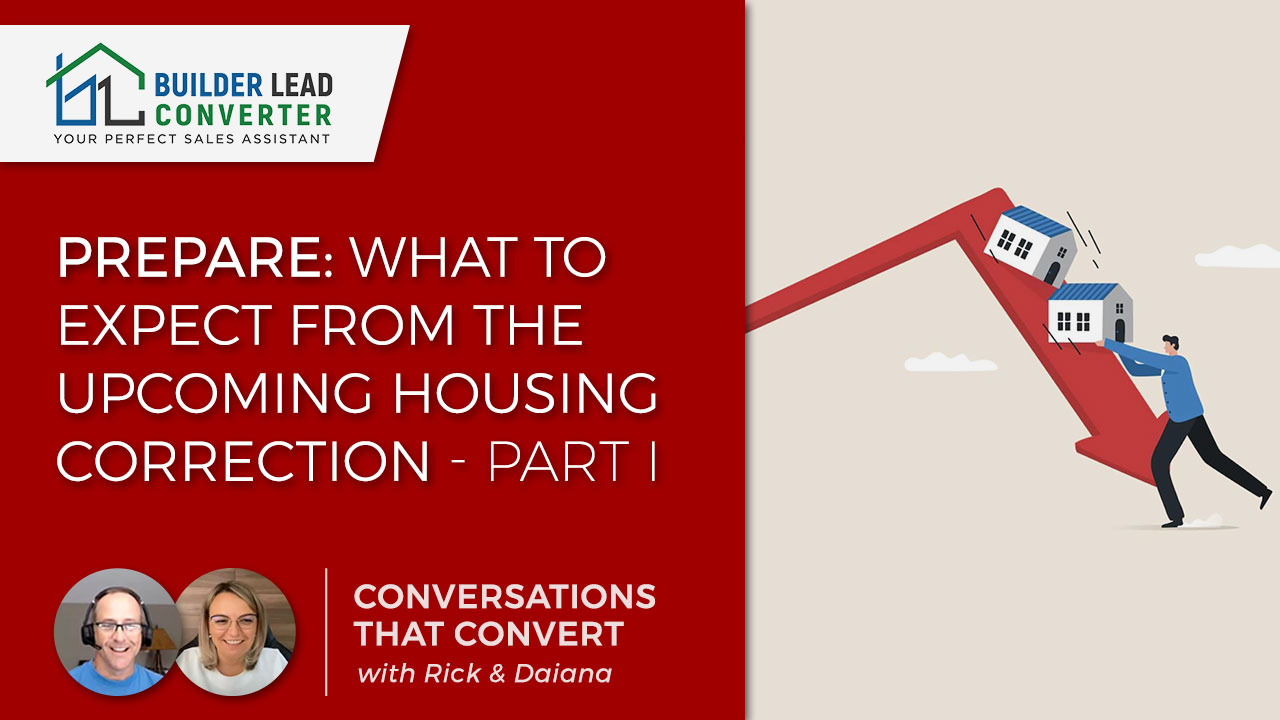Has your lead volume dropped off?
Model traffic slowed down?
Realtor showings in the tank?
The real estate market is always a roller coaster ride and after years of rapid growth, there are signs that the housing market is starting to cool off.
In our latest episode, we’ll take a look at what to expect from the upcoming housing correction and how you can Prepare for it.
In part 1 of, Prepare: What to Expect from the Upcoming Housing Correction, we discuss the three key moves home builders & remodelers can do to Prepare for the impact of a recession on their local housing market.
- Where to reduce credit lines, pay off loans, and conserve cash
- How to get in front of a falling market
- Where to Reduce overhead
It’s important to remember that there is no one-size-fits-all solution when it comes to preparing for a recession. Following our advice will put you in a much better position than those who try to go it alone. So watch/listen to this episode, and stay tuned next week when we wrap up this series with some final thoughts on preparing your business for tough times ahead.
Builder Lead Lead Converter captures & converts leads for home builders & remodelers so they can grow sales revenue and margins. Find out how https://www.builderleadconverter.com/
Transcript:
What to expect from the upcoming housing correction? So let’s get started.
Welcome to Conversations that Convert every week, we’ll spend about 10 to 15 minutes tackling relevant lead generation marketing and sales topics for remodelers, home improvement companies, and home builders. Conversations that Convert is brought to you by builder lead converter, your perfect sales assistant.
And now here’s Rick and Daiana.
Rick: Hey, welcome everyone to conversations that convert. Welcome, Daiana.
Daiana: Hi. Hello. Hello everybody. Good to see you again and looking forward to seeing what wants to happen with this conversation. I’m so excited about the team and what to expect from the upcoming housing correction. And this is part one. And so we prepare for that.
Rick: Exactly. Yeah. So this is all about our series of builders’ guides to recession-proofing your business. And what we’re gonna do this week is we’re gonna look at three key moves that a builder or remodeler can make to prepare for the impact of a recession on their local housing market. And so a couple of things here, number one is, even if we’re in a nationwide recession, we still have to look at your individual local market cuz each market will perform differently. And it’s gonna affect both home builders and remodelers, but probably differently. It also depends on the type of homes you’re building or the type of remodeling projects that you’re doing. But all of this is based on Elon Musk’s strategy for recession, which is to predict, prepare for, and then persevere through a recession. So the last couple of sessions we looked at were giving you data, six data points that you can look at to give you an idea if your local housing market is susceptible to a recession. This week now we’re gonna move into preparing for that. So if you’ve done your homework, you’re looking at what’s going on locally. You’ll say, Hey, you know what, my local housing market is susceptible to recession. So now I need to know what should I prepare for. I’ll give you a quick antidote here, just, just this last week, looking at some data points and things that are happening here in the local market that I live in, we work with clients all over the country, but at least a local market that I, that I live in. We’re seeing, yeah, a lot of. Price reductions in, in homes we are seen, just had a client that actually had to reduce about 5% in order to get one home sold, where they had not done any price reductions for about two years. Have another client that has homes that are newly built for sale. They’ve reduced 10%, and 10%, and they have not gotten a showing on these homes. And so we’re gonna talk about that here today. You know, some of these things that, you know, what you can do to prepare, for the recession and some specific action items. but I don’t know, Dan, should we start with a review of the past four recessions and sort of look at their impact on what happened?
Daiana: Yes. Let’s go ahead. I’m so curious about the past and what’s similar to this one. If we see some similarities or, or differences.
Rick: Yeah, absolutely. We’re gonna take a look at the last four. Let me get this off the screen. So the last four recessions, happened, starting in July 1990 through March 1991. Now, ironically, this is about when I started my career in, in housing, and this was about an eight-month recession. The gross domestic product or GDP declined about 1.5% and then employment peaked at around 6.8%. It was a relatively mild recession. Did not have much impact on housing. And by the way, if those of you that have been around for a long time, If you remember interest rates were around eight, 9%, at, at that time. So they were quite a bit higher than today, but housing was used to it. At that point. We didn’t have these low-interest rates and we pretty much power-powered through it without a whole lot of issues as related to housing. Now the next one was the dot-bomb recession. So for those of you that around in 2001, you remember two major things that happened. One was we had the dot-com collapse or the tech collapse within the stock market. The other one of course was 9-11 where we were attacked. Again, very, very mild recession, probably the mildest recession that we’ve seen in the last 4. GDP declined 0.3% unemployment peaked at 5.5%, again, not much effect on housing. And I remember when I was selling during that time, we actually did well. We, we did, after nine 11, September 2001, we did, we had growth, during that time. So really didn’t affect our local housing market. Then, of course, we have the granddaddy of the mall. The one that we all remember is the great recession. Now, this was an 18-month recession. GDP declined 4.3% unemployment peaked at almost 10%, just under 10% or 9.5, a lot of markets. Housing values went down 30%. I mean, things just dried up. This is where a lot of my home-building clients said, Hey, we gotta start remodeling because no one’s buying homes. A lot of remodelers said, get out of my lane you know, but it, it was a, a real challenge and, and of course, a lot of builders went belly up at that point. The land is a current, really the biggest culprit that actually pulled people down where they had poor land positions, couldn’t get out of ’em and they had to file bankruptcy. And then the last one was, our self-induced. This was the government’s response to the COVID recession. It only lasted two months, from February 2020 to April 2020. The biggest of course issue there was unemployment went from three and a half to 14.7%. However, By the end of 2021, it was backed down to under four. Obviously, these businesses that were forced to close were able to open up, and we went, of course, went through the rehiring process. Um, but as far as GDP and all that, it, it really didn’t affect that. What you need to understand is this, the average length of recession since 1857, varies from length from two months to five years. The average recession is 17 months. The last six recessions since 1980 have lasted less than. 10 months on average. So I think what we’re looking at here if you’re gonna prepare for a recession, what this tells us is that you should be prepared for a 10 to a 17-month downturn in your local housing market. And not every market’s gonna come outta recessions evenly in migration. A lot of people are moving around the country right now which is gonna dramatically affect them. if your local market is gonna go into recession and how long it will last those areas that have more people moving out than moving in are gonna be more susceptible. They’re gonna have a longer period of where it’s gonna be slow. The areas where there are a lot of people moving into it may be not even a blip on the radar for you. So again, the key point here is to understand where your current market is and if you feel it’s vulnerable, then it’s, we’re gonna take some, some action. Any thoughts, Daiana?
Daiana: Yeah. So, it seems that you have to be the right person in the right place. And if you are not just moving with your business, is that a possibility, can you just go and move to another country? Where is its good business? I don’t know. Just that, just the thought. So do you…
Rick: You know, in, Interesting thought because I have had clients that have actually moved into new markets. One in one market has dried up or they’ve got into new offerings. When one offer has, has dried up the gap. The classic example I gave you was during the great recession where a lot of builders there was nobody building homes. So they started remodeling homes, you know? And then you typically what happened at that point is that as soon as the home building came back, they got outta remodel. Because a lot of ’em like, I don’t like remodeling. It’s like, you know, the remodeling is a completely different business model than home building, for a multitude of reasons. But that’s one idea, yes, you could pick up and maybe move to and go after a new location that has more demand going into a different country is, is not real, is probably not really viable, even changing states is very difficult because of licensing and all that changes. But within the state that you’re operating, if you find the market that you feel is underserved or has higher demand. Yeah. That’s definitely a viable, op business opportunity.
Daiana: So what I’m hearing is to be flexible and adapt and adjust until this is going to end or move and just listen to what the market wants. And then. Just, serve that market.
Rick: Exactly. Yeah. Listen to what the market wants. Exactly. So, so let’s talk about some preparation steps. Yeah. If you feel your local housing, market’s vulnerable, what can you do to prepare? All right. The first one is we wanna reduce credit lines, and pay off loans that can serve cash. You’ve heard the term cash is king. Yeah. In a recession that. So true. Those that have the most cash will be able to also find the most opportunities because when the market turns down, opportunities rise up. A lot of times there are more opportunities in a bad market than there are even in a good market. So let’s take a look at this, what does this look like for reducing credit lines, paying off any loans, and conserving? Cash. First of all, from a credit line reduction, if you remember 2007, the great recession, your low-demand locations were the first to get hit and they were the last to recover. In fact, there are still many locations around the country that have not recovered fully from the great recession areas, where there were too many lots developed. So many of those thoughts went back to the bank. It just, there was a lot of foreclosure activity. It really brought the market down. It all goes back to supply. Um, so what we wanna do is we wanna look at those poor locations and we wanna reduce our credit lines as related to those locations. We want to pay off loans there. We wanna conserve as much cash as possible. So, I suggest that you look at each location you’re in and you put a rating on it. So you have an, an, an, a plus location. That’s the best. You have an a, a minus B plus B B minus, and so on and so forth. What you wanna look at is any location that you have rated that is a B minus or lower that’s where you wanna focus on getting out of and case in point when I opened up the program here today that I talked about, you know, reducing five and 10% to get stuff sold. Those are in B minus or below locations. Those are the ones that are already we’re seeing, we’re seeing effects. So number two, we wanna not to chase the market down but get in front of it. So let’s look at a low-demand location and spec home. So we need to reduce prices to get in front of the market. So Daiana, you know, when you jump in a lake, you got two ways to do it, right?
Daiana: Yep.
Rick: You can dip your toe in the water. Woo. And say it’s cold, or you can just say, I’m gonna go for it and jump in. So here we wanna go for it and jump in. Okay. The biggest mistake that builders will make in moving inventory in these low-demand markets is they will, they’ll be too slow to react to the marketplace. You can already see this with the publicly traded home builders. They are always the most aggressive to discount and move on from their product. So when you see those guys, they are offering incentives, discounts, promotions, you know, that’s too. Because they’re always the first out of the gate. So you, if you see that in your market, you need to get in front of it. So don’t chase the market down, but get in front of it. Your days on market kill you because obviously it just costs you money and it also, it potentially is gonna cost you opportunities. So here are a couple of thoughts. number one, if you have a spec home in a low-demand market, do a CMA on it, do a competitive market analysis, and find out what the current market value is. And then go ahead and price it under that, make it look like a screaming deal real quick. something that we just did is we had a, a, a home single family home. It was priced at 580 in the market. We went and did a CMA on it. We saw a lot of homes that were similarly priced. Also had more square footage. So this was a climate where they had basements. So they had the ability to finish the basement. So we raised the price to $20,000. We went up $20,000. We added a basement finish to it, that, that basement finish equated to about a thousand square feet. An extra bedroom and an extra bathroom. So we went from, let’s say a 2,600 square foot home to a 3,600 square foot home. We only went up $20,000. So we took and we dollar cost average our price per square foot. We reduced our overall price per square foot to make us look like a great value. We sat there for two weeks. Now, Daiana, can you guess how many showings we got after two weeks?
Daiana: Zero. I don’t know.
Rick: Zero is right. We got none. The market did not like that. So then we said, okay, we can’t go up and improve the home. So what we’re gonna do now is we’re gonna go down and discount the home. So at that point, we pulled the basement out, cuz it was just on paper. Anyway, we reduced the price from 600 to 570. So it looked like a $30,000 price reduction. Now I’ll ask you another question. Did a $30,000 price reduction. Did that generate a showing? What do you think?
Daiana: Well, I guess not right.
Rick: Oh, we did. We got one.
Daiana: One.
Rick: We got one showing and that one showing turned into an offer of which we were able to negotiate out a sale. So that home that we had at 580, it netted the sale at 553. So that was about a 4.6% dip that we had to take, I would call that location a probably C plus location. So that was 5% right there. The lower grade, the location, the bigger hit you’re gonna have to take. So we got in front of it. So that $30,000 price reduction caught the eye of a buyer. They came in, they smelled blood in the water, and said, okay, I’m gonna pounce. And you know, their first offer, it was not good, but it wasn’t horrible. We were able to work with it and we got the deal done. So that’s, that’s an idea on, on CMAs and spec homes get under the market, look at the market value and then go under. Okay. The next thing to look at is absorption rates and inventory levels. And we talked about this in our prediction program. You have to understand how many homes you’re selling in your local market area and how many homes are for sale. And then understand how many months of the inventory you have. Again, that balanced market is right around five and a half, six months balanced market. Ironically, most locations, even the subpar ones still have less than a six-month supply at homes, but it’s rising quickly. You do not wanna wait till it gets above six months. You wanna still sell when it’s well, below six months? The last thing that I would look at if you own land or lots in subpar locations, is that if you have, had those lots closed. In other words, you will only sell the lot. If you build on it open ’em up, open ’em up to anyone else. Other builders can buy it, sell ’em directly to a consumer, let them pick whatever builder they want, but open ’em up to get away from them. Any other thoughts, Daiana?
Daiana: Yeah, I think it’s a, a very good idea to just jump in the water and then just be brave and, and take responsibility for what wants to happen. And what’s possible and achievable in those times.
Rick: That’s so true about being brave because, you know, we started our price productions in our homes. We started out with a $5,000 price reduction, a $5,000 price reduction. And then we started looking at what the nationals were doing and like, they were doing 10, they were doing. So it’s like, they were just, they were going, you know, they were jumping in that water. We were gripping our toes in that water. So we learned, um, the hard way. It’s like, yeah, we $30,000 price reduction, even though it did it, wasn’t a $30,000 price reduction. It was really only a 10. It got someone’s attention because it looked like we were under the market at that point and they wanted, they were ready to pounce. Okay. Prepare move number three is reducing overhead. I wanna talk specifically about employees. A mentor of mine taught me, many years ago that, there are three types of employees. So type number one is your top performers. This is typically the top 25% of your employees. Now, with that being said, the top 25% they’re accountable, they’re self-motivated. They’re driven. They’re very good at their jobs. You just have, you don’t have to do much for them. You support them as an owner or manager, you get out of their way. Then you have the middle 50% of employees. So that middle 50 are people that, um, you are coaching. You’re investing in the training. You’re trying to move them up to the top 25%. And then the third type of category is the bottom 25%. These are people that have consistently failed to meet the minimum expectation levels and you know, who they are. These are the folks that you’re like, ah, you know what, you know, I like them, but they just continue to make the same mistake over and over again. And no matter how much I coach them, no matter how much I train them, they just don’t get it. These are the people right now that you want to let go of. And here’s the mentality of letting somebody go. Nobody wants to fire somebody because they don’t wanna be bad. You let them dehire themselves. As long as you have set clear expectations of what the minimum level of performance is for this position. As long as you have set that, and you’ve clearly communicated it, they dehire themselves. You’re not firing them. They’re just telling you that they, for whatever reason, cannot meet those minimum level expectations. And then it’s time to set them free. Because a lot of times they’re not in the right job either. They’re not the right person, you know, for you, they’re not the right, not in the right seat on the bus, but they’re also not the right job. Adapt for the right person for the job. So set them free, and get ahead of this. Don’t wait for things to come, you know, to where it really slows down. We’re already in the second half of the year here, things are just gonna get slower from here on out. So you don’t wanna get into that long, cold winter where, you know, you’re, you’re just, you’re overhead and your payroll is really dragging. Into thoughts, Daiana?
Daiana: Yeah, I think it’s a, so basically, you want to reduce statistically 25%. So like, like everyone is trying to do right now and you have to just see who, who is, who is the best fit for, for the job. And then…
Rick: Absolutely.
Daiana: Yeah. They, they, they will live by themselves. That’s the idea, right?
Rick: Yeah. Essentially they are proving to you or have proved to you that they’re not the right person for the job. what, and again, it’s, there can be so many different reasons, but move on from them sooner than later, cuz your overhead will drag on your, on your cash flow.
Daiana: Yeah, that’s a good strategy. So we prepare for what wants to happen in the future.
Rick: Exactly. And those are the first three of the six strategies. So next week, we’re gonna talk about the other three preparation steps that, that, that, that you can take. and if you’d like to schedule a strategy call today, find out how we can help you prepare and prosper in a recessionary housing market. Go ahead and click that link right below this video, and we’d be happy to do that. So for my brothers and sisters in Christ made the grace of the Lord, Jesus Christ, the love of God, and the fellowship of the holy spirit be with you all. We’ll see you next time on Conversations that Convert.






Recent Comments